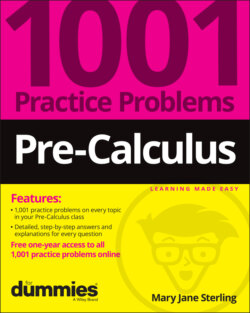Читать книгу Pre-Calculus: 1001 Practice Problems For Dummies (+ Free Online Practice) - Mary Jane Sterling, Mary Sterling Jane - Страница 15
ОглавлениеChapter 8
Graphing Trig Functions
The graphs of trigonometric functions are usually easily recognizable — after you become familiar with the basic graph for each function and the possibilities for transformations of the basic graphs.
Trig functions are periodic. That is, they repeat the same function values over and over, so their graphs repeat the same curve over and over. The trick is to recognize how often this curve repeats and where one of the basic graphs starts for a particular function.
An interesting feature of four of the trig functions is that they have asymptotes — those not-really-there lines used as guides to the shape of a curve. The sine and cosine functions don’t have asymptotes, because their domains are all real numbers. The other four functions have vertical asymptotes to mark where their domains have gaps.
The Problems You’ll Work On
In this chapter, you’ll work with the graphs of trigonometric functions in the following ways:
Marking any intercepts on the x-axis to help graph the curves
Locating and drawing in vertical asymptotes for the tangent, cotangent, secant, and cosecant functions
Computing the change in the period of a function based on some transformation
Adjusting the amplitude of the sine or cosine when the basic curve has a multiplier
Making sideways moves when transformations involve horizontal translations
Moving trig functions upward or downward with vertical translations
What to Watch Out For
When graphing trigonometric functions, some challenges will include
Not misreading the period of the trig function when a transformation involves a fraction
Drawing enough full cycles of the curve to show its characteristics properly
Marking the axes appropriately for the situation
Making use of intercepts when they’re helpful in a graph
Recognizing Basic Trig Graphs
461–465 Determine which trig function equation matches the graph.
461.
Illustration by Thomson Digital
(A)
(B)
(C)
(D)
(E)
462.
Illustration by Thomson Digital
(A)
(B)
(C)
(D)
(E)
463.
Illustration by Thomson Digital
(A)
(B)
(C)
(D)
(E)
464.
Illustration by Thomson Digital
(A)
(B)
(C)
(D)
(E)
465.
Illustration by Thomson Digital
(A)
(B)
(C)
(D)
(E)
Graphing Sine and Cosine
466–470 Sketch the graph of the function.
466.
467.
468.
469.
470.
Applying Function Transformations to Graphs of Trig Functions
471–475 Describe the transformation from function f to function g.
471. to
472. to
473. to
474. to
475. to
Writing New Trig Functions Using Transformations
476–480 Given the description of the transformation from function f to function g, write the function equation for g.
476. Shift left units and up 5 units.
477. Shift right units and down units.
478. Shift right units and down units.
479. Shift left units and down 3 units.
480. Shift right units and up units.
Graphing Tangent and Cotangent
481–484 Sketch the graph of the function.
481.
482.
483.
484.
Interpreting Transformations of Trig Functions
485–495 Describe the transformations from function f to function g.
485. to
486. to
487. to
488. to
489. to
490. to
491. to
492. to
493. to
494. to
495. to
Graphing Secant and Cosecant
496–503 Give a rule for the equations of the asymptotes. Then sketch the graph of the function.
496.
497.
498.
499.
500.
501.
502.
503.
Interpreting Transformations from Function Rules
504–510 Describe the transformation from function f to function g.
504. to
505. to
506. to
507. to
508. to
509. to
510. to
